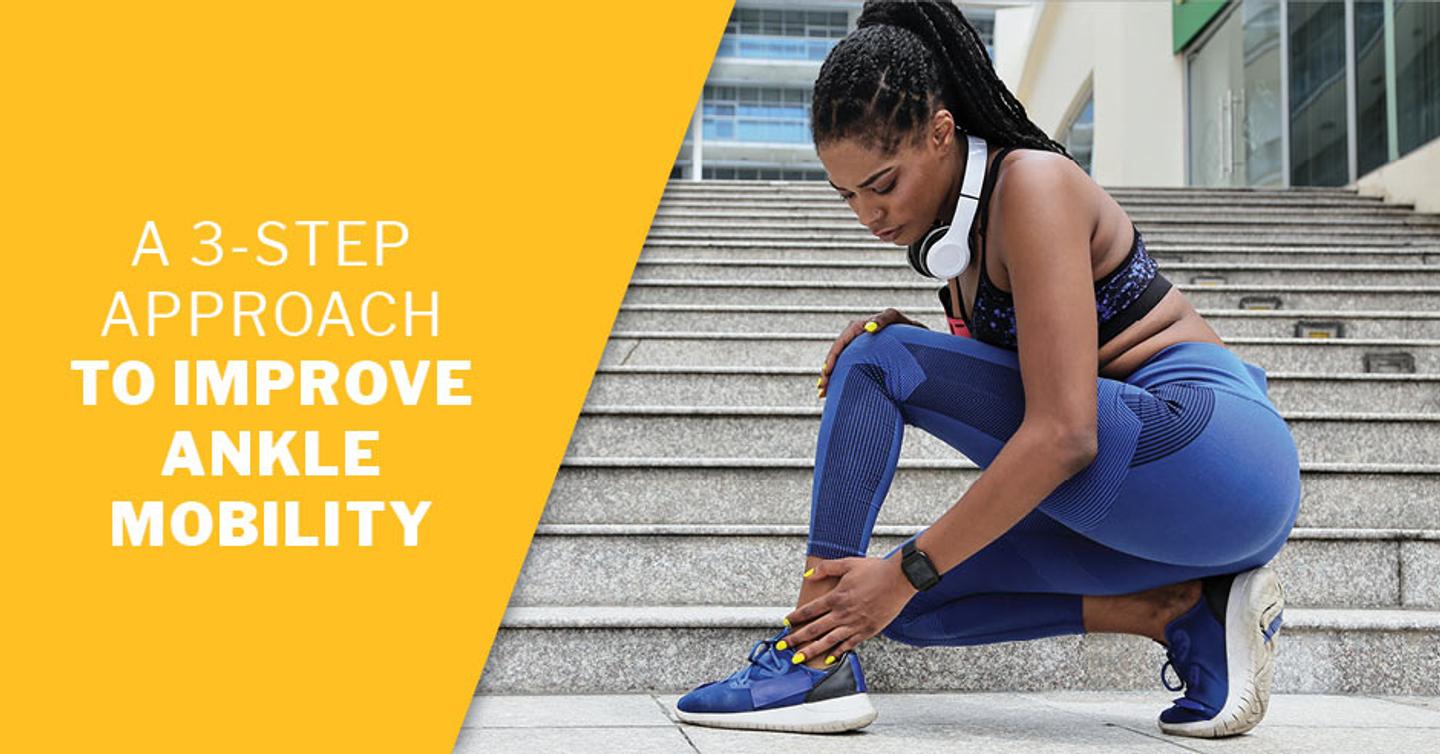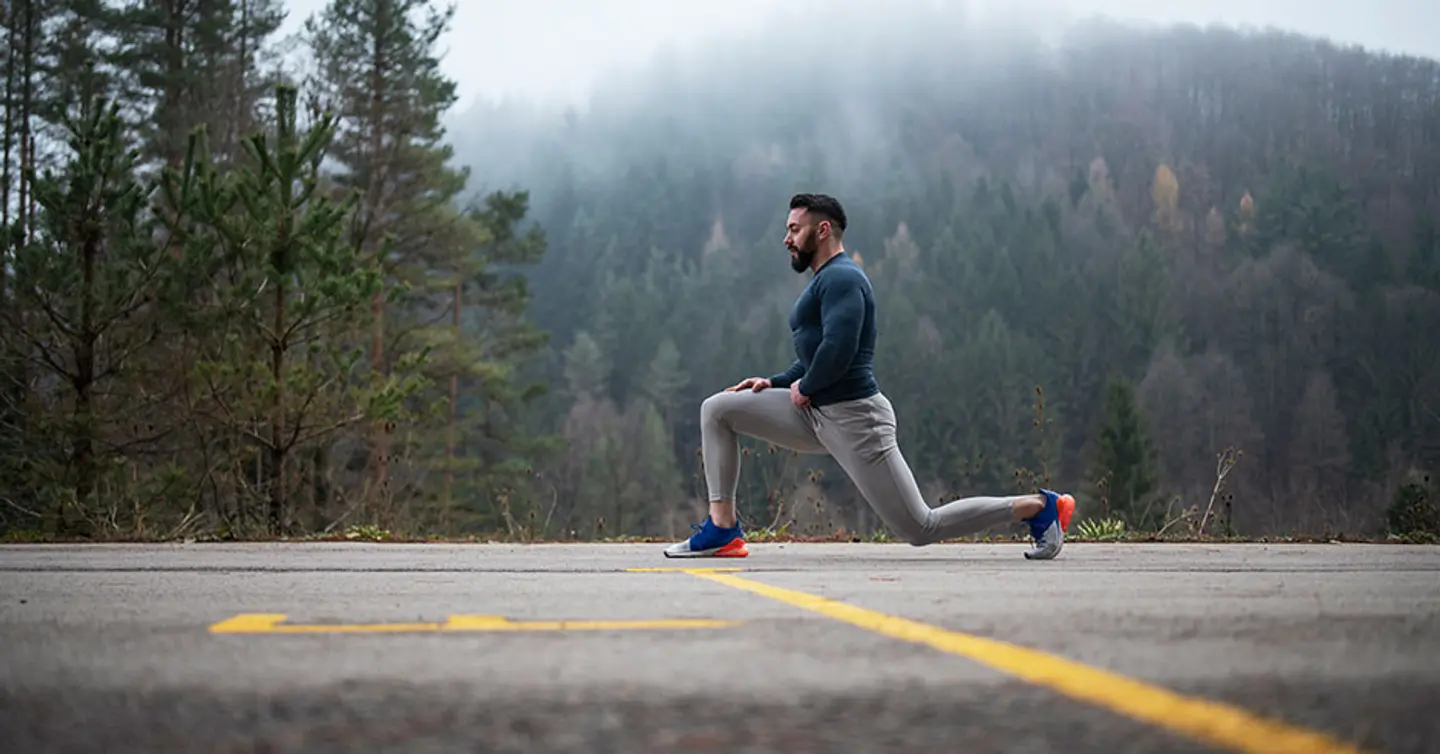
A 3-Step Approach to Improve Ankle Mobility
Reading Time: 6 minutes 19 seconds
BY: ISSA
DATE: 2021-01-06
As a personal trainer, you spend your days helping clients build muscle and lose fat. Yet, improving mobility in the joints is just as important. This is especially true when it comes to the ankle.
Why Ankle Joint Mobility Is Important
Think about all of the exercises you recommend for your clients. For exercises that require the use of the ankle, a good range of motion is needed to support the body's movements. This motion typically involves engaging in plantar flexion movements or dorsiflexion movements. Plantar flexion occurs when pointing the toes down toward the floor. Dorsiflexion refers to pulling the toes upward, as if lifting them toward the sky. Both of these are difficult to do with a stiff ankle.
The force on the ankles varies based on the activity performed. When the client is walking, for instance, the ankle sustains five times the person's body weight. If the client runs for improved fitness, this force is increased to 13 times their weight. Even if this joint is in a static position, it still provides some level of support for the rest of the body.
Tight ankles can also hinder sports performance. For example, a 2015 study looked at ankle mobility and squat depth. After studying 101 subjects, it was determined that ankle dorsiflexion mobility was "significantly associated" with better squat performance.
Including mobility exercises in your client's workouts also helps reduce their risk of ankle injury. A strong ankle is less susceptible to sprains and strains. Poor plantar flexion and dorsiflexion can impact the rest of the body as well. Dysfunction can cause pain that extends into the lower leg, knee, hips, and more.
Causes of Poor Ankle Mobility
Limited ankle mobility can be caused by a number of factors. The first is genetics. Research indicates that individuals with certain risk alleles, alternative forms of a gene, are more like to experience an injury. As noted in the research, those with risk allele chr21:47156779:D are 1.86 times more likely to suffer an ankle injury, and the risk allele rs13286037 is associated with 1.58 times greater risk of injury.
Other studies have connected poor ankle movement with:
gender and age - young females tend to have better ankle range of motion than young males while older males often have better ankle range of motion than older females
presence of disease - conditions such as osteoarthritis can reduce ankle mobility
biomechanical dysfunctions - movement-related dysfunction can increase risk of ankle sprain and other types of injury
Poor ankle mobility can also be caused by the strength of surrounding muscles. According to a 2017 study, ankle dorsiflexion strength is linked to dorsiflexion range of motion. It is also moderately correlated to strength of the first toe flexor muscle.
Stanford Health Care adds that bone spurs, scar tissue, and soft tissue inflammation can all lead to bad ankle mobility. This is called anterior ankle impingement, or footballer's ankle, but its effects can be felt in a variety of additional sports. Symptoms typically include pain and reduced range of motion.
Sometimes poor ankle mobility is a result of training too hard. This type of overtraining injury appears via pain and discomfort in this joint. Other times, ankle mobility declines due to regular training and competition.
A February 2020 study looked at ankle dorsiflexion in 40 professional football players. They found that dorsiflexion range of motion was greatest pre-season, decreasing mid- and post-season. Range of motion also decreased 48 hours after a match, placing players at increased risk of an injury to this joint.
How Do You Know If Ankle Mobility Issues Exist?
Research shows that a normal range of motion for ankle dorsiflexion is somewhere between 10 and 20 degrees. Average plantar flexion is 40 to 55 degrees. If your client has trouble with these angles, ankle mobility may be restricted.
Pain is another indicator that ankle mobility may be an issue. This pain may occur when flexing the foot up or down. It's important to note that sometimes this pain is a result of other foot injuries. For example, plantar fasciitis—which is a swelling or irritation to the plantar fascia ligament on the bottom of the foot—can cause pain to radiate to the ankle. For this reason, if the client is experiencing chronic or consistent ankle pain, they should see their physician to find the cause.
If your client's heels come off the ground when they perform a squat, this is another sign that mobility may be hindered. There's also a test you can have them do to check their ankle range of motion. Have your client stand so their big toe is roughly two inches from the wall. Keeping their heel on the floor, ask them to bend their knee and try to make contact with the wall. If this causes pain or they report tension in their ankle or calf muscle, there is limited mobility in their ankle joint.

A 3-Step Approach to Improving Ankle Mobility
Helping clients achieve good ankle mobility involves following a 3-step approach that includes strength training exercises, stretching, and ankle mobility drills.
Step 1: Strength Exercises that Improve Ankle Mobility
There are a number of mobility exercises that can help strengthen this joint. Strength-based ankle exercises to consider including in your client's workout regimen include:
Heel lifts. While standing, have the client lift their heels off the ground.
Toe raises/heel drops. This ankle mobility exercise is performed while standing on a step and involves alternating between rising up on the toes and letting the heels drop toward the ground.
Toe/heel walks. Have the client walk a specific distance entirely on their toes. Ask them to walk the same length back, this time on their heels.
Lunge. Performing a lunge while staying in place (static lunge) helps improve ankle mobility. Walking lunges are beneficial as well.
Overhead squat. This total body squat strengthens mobility in a variety of joints. In addition to the ankle, this includes the knee, hip, and shoulder joints too.
Ankle flexion exercises. Clients can improve ankle mobility by doing both plantar ankle flexion exercises and dorsiflexion ankle exercises. Have them use resistance bands for even better effects.
Step 2: Stretches for Increased Ankle Flexibility
Researchers from Australia's Queensland University of Technology conducted a review of 23 ankle dorsiflexion studies. Together, these studies included 734 participants. Based on the findings, they determined that static stretching helps improve ankle joint dorsiflexion range of motion.
What are the best stretches to improve ankle mobility?
Big toe stretch. Clients can do this stretch in a sitting or standing position. It involves bending the toes up and back until you feel a stretch along the plantar fascia muscle.
Toe-wall stretch. For this one, you stand with the top of your foot against the wall, toes pointing toward the ceiling. With the heel resting on the floor, shift your body forward to stretch the ankle.
Ankle circles. This exercise involves rotating the ankle joint in circles. Alternate between clockwise and counterclockwise movements.
Ankle end-range isometric stretch. Have the client place one knee on the ground with the other knee bent so they are in a semi-kneeling position. Lean forward so the knee hovers above the toes and push that foot into the ground. This helps stretch the ankle.
Step 3: Ankle Mobility Drills to Include in Your Workouts
The third piece of an exercise program that improves ankle function is mobility drills. These are movements that don't fall into the category of strength training or stretching. Often, these drills can be incorporated in the cardio portion of your client's program.
Ankle jumps and single-leg hops are two mobility exercises that help improve poor dorsiflexion. These can be suggested on their own, or they can be performed in conjunction with other movements. For example, clients could transition from a squat into ankle jumps, providing a full-body workout.
Improving Ankle Mobility After an Injury
If the client has injured their ankle, caution must be used when improving ankle mobility. If the area still has pain or the injury was recent, they should first obtain permission from their doctor. Once that is received, corrective exercises can help build and strengthen this joint.
For example, if the client has sustained an ankle tendon injury, have them write the alphabet with their toes. This gets the ankle moving in all directions, improving overall range of motion. If the ankle has been fused, replace a jumping mobility drill with more static movements instead. This helps strengthen the ankle without placing undue pressure on it.
If the client has knee pain along with limited ankle mobility, leg lifts with the foot pointed and then flexed can help improve function. Foam rolling post-ankle injury also helps improve blood flow to the area. Simply rub the foam roller against the top of the ankle. You can use it on tight calves as well, helping the ankle and foot to relax.
To learn more about what type of exercises are helpful to clients experiencing muscle or movement limitations, the ISSA offers a Corrective Exercise Specialist Certification. In this course, you will learn some of the most common dysfunctions, as well as which exercises help improve movement. It also teaches you how to help your clients restore their structural alignment.